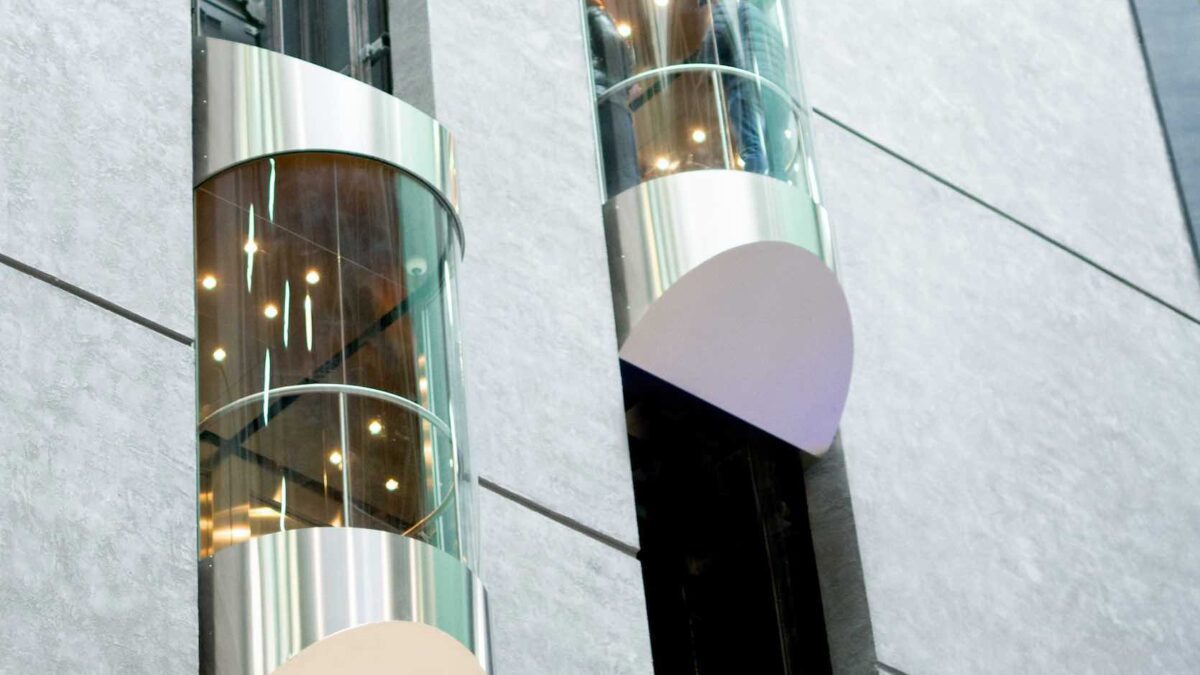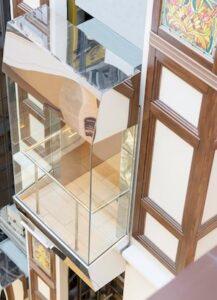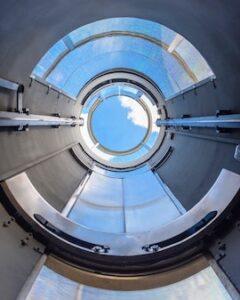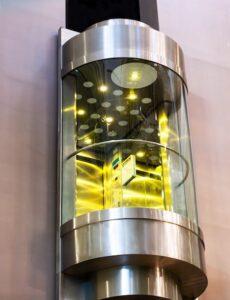
Why Roys Rise Custom Elevator Company is Architects 1st Choice?
October 21, 2019
Birdcage Elevator
January 14, 2020Custom elevator design is an integral aspect of luxury homes and high-end commercial buildings. This article explores five crucial factors architects, interior designers, and homeowners should consider when incorporating a custom elevator into their design plans.
1. Space planning for custom elevator
Elevator as a Focal Point
The strategic placement and design of a custom elevator are crucial in both residential and commercial spaces. Whether it’s a luxury home or a high-end commercial building, a well-designed elevator can transition from a mere functional element to a central architectural feature. This transformation enhances both the aesthetics and the value of the property.
Designing with Specific Elevator Types in Mind
In commercial settings, a custom commercial elevator can serve as a centerpiece, showcasing the building’s modernity and commitment to luxury. For a more visually striking design, a circular elevator can be a unique choice, offering a 360-degree view that captivates and impresses. Additionally, a glass round elevator not only serves as a stylish and functional piece but also adds an element of sophistication, allowing natural light to permeate the space and offering panoramic views. These elevator types, when thoughtfully integrated into the building’s design, can transform an ordinary space into a remarkable architectural statement.
2. Lighting in Custom Elevator Design
Lighting is another key factor in designing a luxury home or shopping mall with a custom elevator. The elevator cabin and shaft lights could be flat lights on the floor or ceiling or highly focused lights designed to direct vision toward the focal points. Also, in the case of a full glass elevator, natural lighting can come from the glass ceiling. Accent lighting is a way to add style and grace to your home or building. These lights can illuminate parts of the house, including the elevator you want to display beautifully, while other elements are in the shade. You can use focused light to highlight the beauty of your home or building’s elevator.
The accent light creates a captivating atmosphere and evokes the sense of impact and importance of the images displayed. They usually use these kinds of lighting in museums, historic buildings, and art exhibitions. Spotlights, such as halogens, are often used to illuminate the elevator roof, and surface lights can be used on the elevator floor using opaque glass or unique stones.
Architectural lighting is just as important as the architecture itself. Using different materials, colors, and textures with varying types of lighting like Swarovski crystal lighting can affect how people feel and how they experience a space. Whether that is a natural or artificial light, it enables us to appreciate the elevator and notice aspects we might not have seen without lighting. Next time you are in a museum, office building, library, sporting arena, etc., take a minute to observe the lighting and how it interacts and adds value to the architecture.
3. Custom Elevator Shaft Design
Elevator Shaft as an Architectural Element
A custom elevator shaft for a luxury glass elevator or a classic birdcage lift, for example, should be designed to create a smooth and elegant space based on the modern or traditional design of a house or commercial building. For example, a classic building can be designed and built with a gorgeous shaft using glass, wrought iron, or colored stainless steel. A home reflects the owner’s distinctive style, persona, and elegance through quality, craftsmanship, and details. Whether the shaft is glass or wrought iron, the elevator should bring about the feeling of old-world charm and creates a dramatic first impression. Incorporating a classic ornamental iron design in the shaft or a modern, more simplistic design that captures the home aesthetic or a hotel’s architectural and interior design is essential.
4. Elevator Architecture
Integrating the Elevator into the Building’s Design
Custom elevator architecture is another essential factor to consider when designing a luxury home or commercial project with a custom elevator. Like all other building spaces, the elevator should also have harmony and integrity with the overall architectural design concept and other building elements. When thousands of dollars are spent on a project to provide building materials such as cabinets, stone, etc., choosing an elevator with a unique architectural design as a heavy feature in expressing the concept of building design, an eye-catching element is a must. A luxury elevator, like a luxury car, will enhance the architectural design of the elevator and improve the attractiveness and value of the project. It will also provide comfort to the residents or owners of the building.
 5. Material Selection
5. Material Selection
Choosing the Right Materials
Material selection is one of the most significant factors for designing a luxury home or building with a custom elevatorThe materials used in the construction of the elevator can have a significant impact on its appearance and functionality. Glass, wood veneer, and stainless steel are popular choices, each offering unique advantages.
Glass (Laminated)
Flat and curved glass are excellent materials for a luxury elevator. The visual merging of living space and nature generates a pleasant and roomy atmosphere. The material meets today’s generation’s desire for more transparency: A 360° view outward and inward lends a sense of space to any area. Exceptional design concepts are possible with glass cabs. For example, our custom elevator project in the Museum of Modern Art features a circular elevator. That is beautifully centered in the middle of the museum with an ultra-clear safety laminated curved glass, leaving a spacious feeling achieved by a panoramic elevator design. Our exclusive under platform door operator, “Galaxy,” is used to eliminate all the components on the top of the cab, leaving a flush clean glass ceiling.

Wood Veneer
Wood veneer is an excellent option for your home elevator design, combining exceptional durability with the warmth and charm of wood, allowing you to create the look and feel that suits your interiors.
The options are limitless, with range of veneers such as oak, white oak, birch, walnut, cherry wood, etc. You can apply them to elevator cab design and elevator shafts.

 Stainless Steel
Stainless Steel
Stainless steel is an excellent choice of material in a custom home or a shopping mall elevator. Stainless steel, by nature, creates character, lighting effects, product longevity, and durability. The quality and neatness of colored or patterned stainless steel increasingly fascinate the architects and interior designers. Besides, these materials do not succumb to the effects of damage from exposure to heat, chemicals, or water damage. Such characteristics make stainless steel a perfect match for elevator manufacturing. The quality also makes it a very hygienic material. Stainless Steel is also an environmentally sustainable choice, being it completely recyclable.

 Design Flexibility in Architecture
Design Flexibility in Architecture
Another characteristic of stainless steel is its extreme versatility. You can apply a wide range of standard and custom shapes to create nearly every component of an elevator. Using stainless steel in your elevator construction provides scratch-resistant, durable, anti-graffiti lift doors, cabins, and architraves. Also, stainless steel helps reduce the carbon footprint on the environment. Stainless steel alloy is almost 100 percent recyclable. Its lightweight nature makes stainless easy to transport and erect quickly, making it the material of choice in elevator architecture. A diverse range of stainless steel is available to accommodate any designer’s unique vision, from durable patterned finishes to flat surface finishes. There are many choices on either satin, mirror, super mirror polishes, Vortex, and Granex finishes on natural stainless steel. They can also apply colored stainless steel and patterned Metal Art finishes for the following areas:
- Control Operating Panel / Press Plates.
- Architraves and Door Cladding.
- Elevator Car Cladding.
- Interior Elevator Cladding.
- Handrails
- Ceiling Panels.
 Powder Coating
Powder Coating
Powder coating is a great option that allows homeowners or builders to customize the color of the cab frame to match the existing building color scheme. Powder coating is
the finish choice for many designers looking for a superior, colorful, long-lasting, and durable finish on architectural applications. The powder coating makes the cab scratch-resistant, improves gloss retention, and has quality weather ability. To decide the best powder coating colors for your cab, you can look at actual powder-coated chips and see which ones best fit your home interior design. You’ll have an unlimited range of color options, finishes, glosses, and textures for your lift. You can use these decorative and protective finishes on a range of materials. Our team finishes every architectural piece of the elevator by hand with artistically applied colorants and glazes. Metal is a natural material and has variations in grain, color, tone, feel, and weight. Therefore, natural variations in these characteristics are unavoidable and help make your product unique.
Elevating Design Standards with Custom Elevators
Make Roys Rise custom elevators a part of your next renovation or new architectural build. Our professional designers and engineers partner with every one of our customers to create unique and luxurious elevators. Find out more about us and get in touch today to see how our luxury elevators can make a big difference in the look of a building’s architecture.







 5. Material Selection
5. Material Selection Stainless Steel
Stainless Steel Design Flexibility in Architecture
Design Flexibility in Architecture Powder Coating
Powder Coating